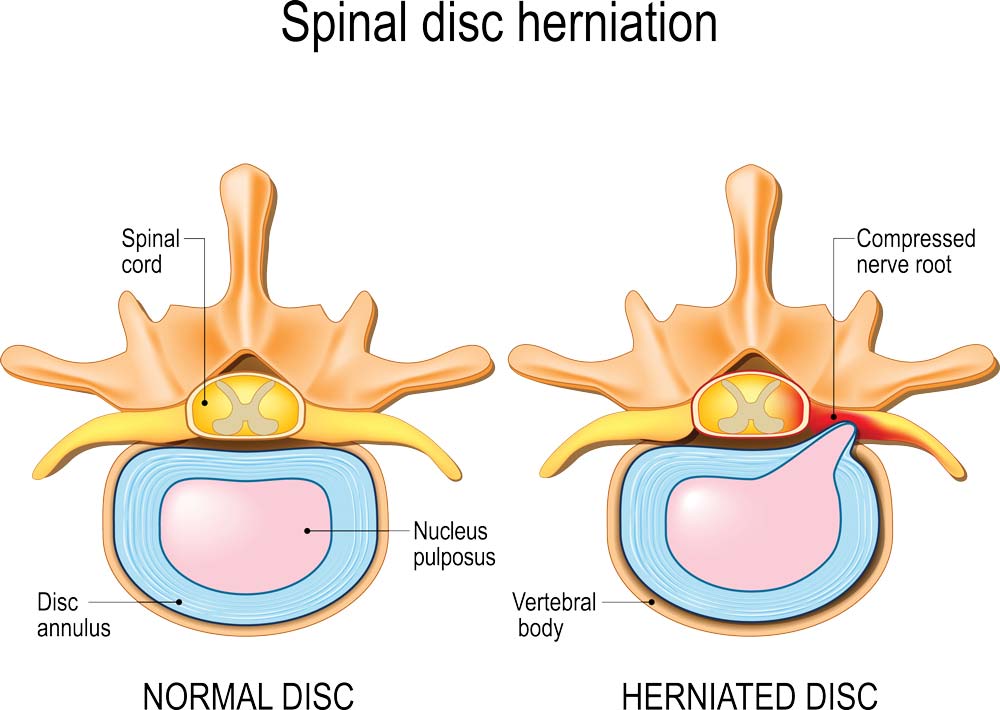What is a Bulging Disc and How is it Treated?

What is a bulging or a herniated disc injury?
A bulging disc injury is a common but treatable spinal injury which can occur in any part of your spine. The vertebrae in our spine are separated by discs which act like cushions or shock absorbers. These discs have a tough outer shell and a softer centre. Wear and tear from daily activities can cause the outer part of the vertebrae to weaken and lose shape. This may cause the outer shell of the disc to bulge into the spinal canal. A herniated disc injury occurs when there is a crack in the outer shell and some of the soft centre protrudes out of the disc. Herniated discs can also be called ‘slipped’ discs. This type of injury is more likely to cause problems as the protrusion tends to be bigger.
These types of injuries can become problematic as the bulging or herniated disc applies pressure on nerves, which can lead to pain, tingling or weakness in areas supplied by those nerves such as the arms or legs.
Disc herniation occurs in progressive stages:

1. Disc Protrusion
occurs when the gelatinous inside of the disc bulges but does not rupture the outer shell of the disc. The inner disc remains contained within the disc structure.
2. Disc Prolapse
is when the soft gelatinous inside of the disc is still contained within the discs outer shell but only because the outermost fibres are holding it in. It is kept just inside the outer boundaries but the outer round border of the disc has become misshapen. This can cause the disc to impinge on the nerves that run in very close proximity parallel to the disc.
3. Disc Extrusion
This is when the soft material comprising the nucleus (centre) escapes from the outer shell but is still connected to the disc. This is possible due to tears in the outer ring fibres that leave an opening from which the soft material can flow. This also can cause the disc to impinge on the nerves that run in very close proximity parallel to the disc.
4. Sequestered Disc
This is when the gelatinous material the comprises the inner disc and the fibres from the outer ring have detached from the rest of the disc and are now free-floating in the spinal cord. This can cause variable neurological symptoms as the disc moves up and down the spinal canal.
What are the causes and risk factors of a disc injury?
Bulging disc or herniated disc injury can occur from a variety of causes and risk factors. The most frequent cause of this type of injury is general wear and tear of the spine and ageing, however, there are other factors that can contribute to the degeneration of your discs at a faster rate.
One of these factors is poor posture, which can put unnecessary stress on our spine, causing our discs to become weaker at a faster rate. Poor posture can stem from a variety of activities such as sitting at a computer for extended periods of time, or strenuous activities which includes lifting heavy items.
Another cause is a direct spinal injury. A spinal injury that occurs as a result of an accident or sporting injury has the potential to cause a bulging or herniated disc injury.
Lifestyle factors such as smoking and inactivity have additionally been found to increase the degenerative process, which increases the risk of obtaining a bulging disc injury.
What are the symptoms of disc injury?
Symptoms of a bulging disc come as a result of the disc pressing on nerves. These symptoms can include tingling, pain or weakness of areas that are connected to those nerves. Given that bulging disc injury can occur in any part of the spine, symptoms can be seen in a variety of different areas of the body.
- Symptoms of bulging disc injury which occur in the neck area (cervical spine) include both neck and shoulder pain, in addition to tingling, pain and weakness in arms, hands and fingers
- Symptoms which occur in the upper back (thoracic spine) include pain in the upper back area, pain or discomfort in the chest similar to that of lung or heart problems, and pain in the stomach
- Symptoms indicating a bulging disc in the lower back (lumbar spine) include lower back pain, tingling or numbness in the leg and muscle spasms.
What is the treatment for a bulging/herniated disc?
Depending on the severity and cause of the disc injury, chiropractic treatment may be a great form of treatment that can provide pain relief to those who have sustained a bulging disc injury. Regular visits with your Back Pain Relief Clinic chiropractor ensure that joints and surrounding soft tissue affected by a disc bulge are restored to a healthy comfortable state.
Written by
Dr Thomas Lawrence
Director
Back Pain Relief Clinic
(BSc, BClinChiro)
Learn more about how we treat, or book a Chiropractic appointment online.

Hi! Would you mind if I share your blog with my myspace group?
There’s a lot of folks that I think would really enjoy your content.
Please let me know. Cheers
No Worries